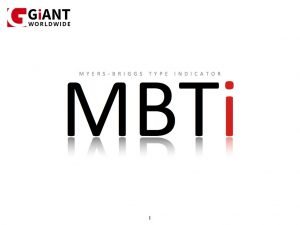Crosscultural communucation Getting yourself prepared on living and

















- Slides: 17

Cross-cultural communucation Getting yourself prepared on living and working abroad Session 2 www. businet. org. uk Edinburgh 2011 www. khbo. be

2 Cross-cultural communication

Cross-cultural communication What’s your communication style? Circle one of the numbers to indicate how you rate yourself between the two items. q q q Confident Passive Responsive Easy-going Take charge Formal Disciplined Communicate readily Accepting Unorganized Initiate social contact 1 1 1 2 2 2 3 3 3 4 4 4 Reserved Aggressive Self-controlled Dominant Goes along Informal Spontaneous Reserved Challenging Organized Lets others initiate etc 3

Cross-cultural communication What’s your communication style? 1. 5. 8. 11. 13. 15. 19. 21. 25. _____ _____ _____ Sum A = _______ 2. 4. 9. 12. 16. 23. 26. _____ _____ Sum B =____ 4

Cross-cultural communication What’s your communication style? Sum A + 35 – Sum B = _____ divided by 16 = _____ Place an X on the following scale corresponding to the score above: DOMINANT EASY-GOING Idem formal and informal communication 5

(Extrovert) Easy-going Dominant Informal (people-oriented) (Introvert) Cross-cultural communication What’s your communication style? Formal (Task-oriented) 6

7 Cross-cultural communication

Cross-cultural communication Communication styles Map your own communication styles and compare with your team members Ø Several varieties of communication behaviours. Ø These 8 styles are grouped into pairs, each of which represents the end points of a continuum. Ø Between each pair on the line, mark an X to indicate your personal communication style. Ø Use your interactions with people in the host country as the basis for evaluation or ask a cultural informant. 8

Cross-cultural communication (1) Direct – indirect communication q Direct communication Communication is done using explicit verbal statements and represents exactly what the speaker means. There is very little ‘beating around the bush’ there. q Indirect communication Meaning is communicated using indirect means such as suggestions, body language, or pauses. This style often uses other people to resolve conflict instead of direct contact. q You ? Direct -------------------- Indirect 9

Cross-cultural communication (2) Linear – circular communication q Linear communication This style is similar to direct communication as it gets to the point without going off on tangents. The communication progresses systematically along a straight line until the point is made. As such it is considered faster and more economical to the people who use it. q Circular communication In circular communication, the person rarely states the point directly. Instead, a discussion proceeds in a roundabout way and incorporates many details until the point is reached. This way of communicating is similar to how stories are told q You ? Linear -------------------- Circular 10

Cross-cultural communication (3) Detached – attached communication q Detached communication In detached communication, issues are discussed with calmness and objectivity. Emotion is kept at a minimum, and objectivity is preferred over subjectivity. People who use detached communication may feel that they are just being rational and fair. q Attached communication This communication style is characterised with a high level of emotion and feeling. People communicating this way think that they are showing sincerity or personal concern for the topic and the person with whom they are interacting. q You ? Detached ------------------- Attached 11

Cross-cultural communication (4) Idea-oriented – relationship oriented communication q Idea-oriented communication In this form of communication, disagreement with ideas is stated directly, with the assumption that only the idea, not the person from whom the idea came, is being attacked. Phrases such as “no offence, but I don’t agree with you” or “agree to disagree” are indicative for this style. q Relationship-oriented communication In this communication style, disagreeing with an idea is viewed the same as disagreeing with the person who originated it. Intellectual disagreement in particular is handled more subtly and indirectly. This communication style emphasises interpersonal harmony and strives to maintain the relationship between people. q You ? Ideas ----------------- Relationships 12

Cross-cultural communication Listening skills q How can you encourage people to listen to you while you are talking ? q How do you notice that your audience is no longer interested in what you are saying ? 13

Cross-cultural communication Listening skills q Hearing q Understanding q Judging q Tips for being a good listener : Ø Attention and focus Ø Finish listening before speaking Ø Ask questions Ø Give feedback (main ideas) q Watch the movie 14

15 Cross-cultural communication

Cross-cultural communication Things to read q Workplace communication skills q Why woman don’t understand man… 16

Cross-cultural communication TEAM ASSIGNMENT - SESSION 2 q Look at the skills you and your team members listed for the profiler game. q Does the view that your team members have on you correspond to your own personal view on yourself? q What are the first impressions others have of you? Try to restrict it to positive impressions. q What can be improved and how on those first impressions? q What are the main charachteristics of your own communication style? Can you also identify your weaknesses? q How do your team members assess your communication style? 17
 The secret to getting ahead is getting started
The secret to getting ahead is getting started Know yourself to lead yourself
Know yourself to lead yourself Check yourself before you wreck yourself origin
Check yourself before you wreck yourself origin Myself yourself herself
Myself yourself herself Ict in education images
Ict in education images Imagine yourself as a living house chapter
Imagine yourself as a living house chapter Living beyond yourself
Living beyond yourself Ecosystem living and nonliving things
Ecosystem living and nonliving things Is moss living or non-living
Is moss living or non-living Living non living dead
Living non living dead Mitochondria information
Mitochondria information List three examples of in-transit foodservice operations
List three examples of in-transit foodservice operations Why is carcase meat prepared into cuts joints and mince
Why is carcase meat prepared into cuts joints and mince The accepted standard of sound and rhythm is
The accepted standard of sound and rhythm is Prepared and resilient learner
Prepared and resilient learner The business plan should be prepared by
The business plan should be prepared by After a node has prepared an lsp it must be disseminated to
After a node has prepared an lsp it must be disseminated to Dramatic irony romeo and juliet act 4
Dramatic irony romeo and juliet act 4































